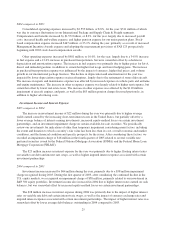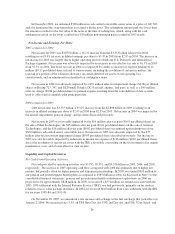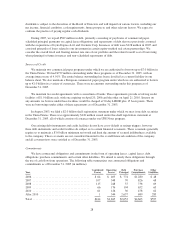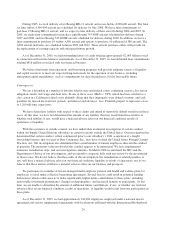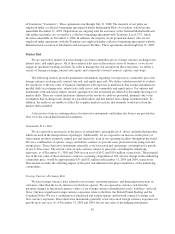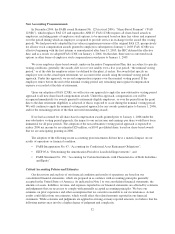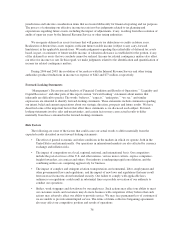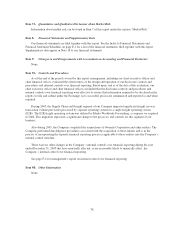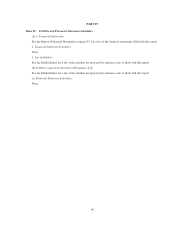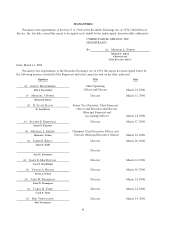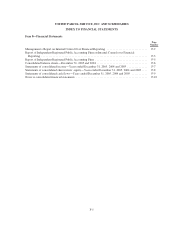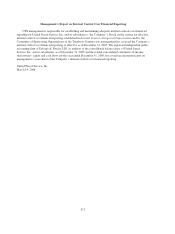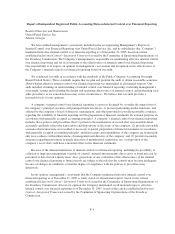UPS 2005 Annual Report Download - page 50
Download and view the complete annual report
Please find page 50 of the 2005 UPS annual report below. You can navigate through the pages in the report by either clicking on the pages listed below, or by using the keyword search tool below to find specific information within the annual report.volatility factors. Changes in the fixed income, equity, foreign exchange, and commodity markets will impact our
estimates of fair value in the future, potentially affecting our results of operations. A quantitative sensitivity
analysis of our exposure to changes in commodity prices, foreign currency exchange rates, interest rates, and
equity prices is presented in the “Market Risk” section of this report.
Depreciation, Residual Value, and Impairment of Fixed Assets—As of December 31, 2005, we had
approximately $15.289 billion of net fixed assets, the most significant category of which is aircraft. In accounting
for fixed assets, we make estimates about the expected useful lives and the expected residual values of the assets,
and the potential for impairment based on the fair values of the assets and the cash flows generated by these
assets.
In estimating the lives and expected residual values of aircraft, we have relied upon actual experience with
the same or similar aircraft types. Subsequent revisions to these estimates could be caused by changes to our
maintenance program, changes in the utilization of the aircraft, governmental regulations on aging aircraft, and
changing market prices of new and used aircraft of the same or similar types. We periodically evaluate these
estimates and assumptions, and adjust the estimates and assumptions as necessary. Adjustments to the expected
lives and residual values are accounted for on a prospective basis through depreciation expense.
In accordance with the provisions of Statement of Financial Accounting Standards No. 144 “Accounting for
the Impairment or Disposal of Long-Lived Assets” (“FAS 144”), we review long-lived assets for impairment
when circumstances indicate the carrying amount of an asset may not be recoverable based on the undiscounted
future cash flows of the asset. If the carrying amount of the asset is determined not to be recoverable, a write-
down to fair value is recorded. Fair values are determined based on quoted market values, discounted cash flows,
or external appraisals, as applicable. We review long-lived assets for impairment at the individual asset or the
asset group level for which the lowest level of independent cash flows can be identified. The circumstances that
would indicate potential impairment may include, but are not limited to, a significant change in the extent to
which an asset is utilized, a significant decrease in the market value of an asset, and operating or cash flow losses
associated with the use of the asset. In estimating cash flows, we project future volume levels for our different air
express products in all geographic regions in which we do business. Adverse changes in these volume forecasts,
or a shortfall of our actual volume compared with our projections, could result in our current aircraft capacity
exceeding current or projected demand. This situation would lead to an excess of a particular aircraft type,
resulting in an aircraft impairment charge or a reduction of the expected life of an aircraft type (thus resulting in
increased depreciation expense).
In December 2003, we permanently removed from service a number of Boeing 727 and McDonnell Douglas
DC-8 aircraft. As a result, we conducted an impairment evaluation, which resulted in a $75 million impairment
charge during the fourth quarter for these aircraft (including the related engines), $69 million of which impacted
the U.S. domestic package segment and $6 million of which impacted the international package segment.
In December 2004, we permanently removed from service a number of Boeing 727, 747 and McDonnell
Douglas DC-8 aircraft. As a result of the actual and planned retirement of these aircraft, we conducted an
impairment evaluation, which resulted in a $110 million impairment charge during the fourth quarter for these
aircraft (including the related engines and parts), $91 million of which impacted the U.S. domestic package
segment and $19 million of which impacted the international package segment.
These charges are classified in the caption “other expenses” within other operating expenses (see Note 13 to
the consolidated financial statements). UPS continues to operate all of its other aircraft and continues to
experience positive cash flow, and no impairments of aircraft were recognized in 2005.
Income Taxes—We operate in numerous countries around the world and are subject to income taxes in
many jurisdictions. We estimate our annual effective income tax rate based on statutory income tax rates in these
35


